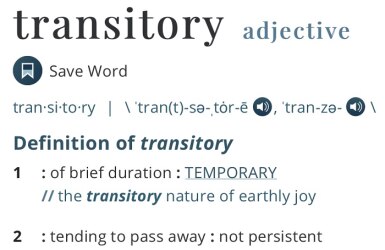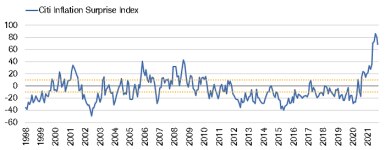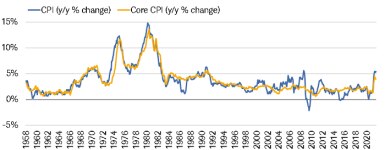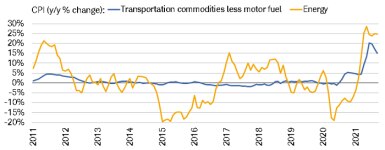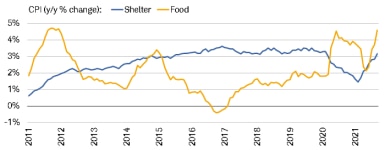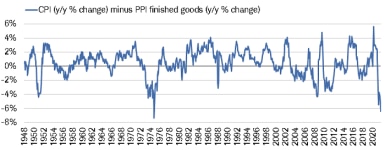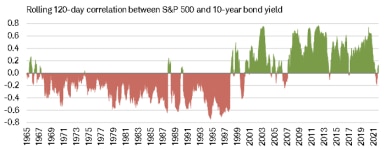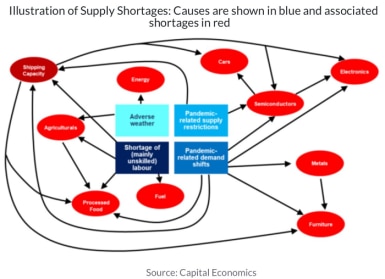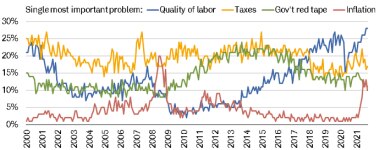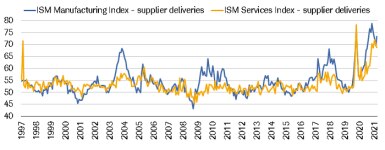The Beast of Burden of Inflation
Was the COVID recession a traditional recession in the sense that it represented the bridge from the end of one economic cycle to the start of a new economic cycle? Or, might it be more aptly thought of as a war that interrupted/disrupted an ongoing economic cycle? If the answer is the latter, it helps explain some of the economic and inflation data that looks eerily late-cycle. Although we do not believe the pillars are yet in place to support a 1970s-style stagflation scenario, we are clearly in a weakening growth/high inflation era that appears less “transitory” every day.
See the Merriam-Webster dictionary definitions of stagflation and transitory.
Although inflation is behaving with “persistence,” consumer demand is not “stagnant,” and the unemployment rate has been falling amid a very tight labor market. Interestingly, there is a dual definition of “transitory,” with inflation not falling in line with the “brief duration” definition—even if it might ultimately qualify for the “not persistent” version of the definition.
Stagflation lite
In recent reports, I’ve been highlighting the vastly different trajectories of economic and inflation surprises. The charts below show how economic data and inflation readings are coming in relative to consensus expectations. Although a bottom may have formed for economic surprises, they remain in negative territory; and although a top may have formed for inflation surprises, they remain historically stratospheric. As shown in the accompanying tables, the S&P 500 has historically had weak performance in these zones. Interestingly though, when inflation surprises have run hot historically, small cap stocks tended to outperform a larger cap index like the S&P 500.
Economic Surprises Weak
Source: Charles Schwab, Bloomberg, ©Copyright 2021 Ned Davis Research, Inc. Further distribution prohibited without prior permission. All Rights Reserved. See NDR Disclaimer at www.ndr.com/copyright.html. For data vendor disclaimers refer to www.ndr.com/vendorinfo/, as of 10/15/2021. Indexes are unmanaged, do not incur management fees, costs and expenses and cannot be invested in directly. Past performance is no guarantee of future results.
Inflation Surprises Elevated
Source: Charles Schwab, Bloomberg, as of 9/30/2021. The Citi Inflation Surprise Indices measure price surprises relative to market expectations. A positive reading means that inflation has been higher than expected and a negative reading that inflation has been lower than expected. Indexes are unmanaged, do not incur management fees, costs and expenses and cannot be invested in directly. Past performance is no guarantee of future results.
As shown below, the consumer price index (CPI)—both at the core and headline level—has jumped sharply this year, but remains well below the spikes in the mid-to-late-1970s. The rub is that most of what we use and need every day is contributing to elevated inflation, including energy, autos, food and shelter (see lower charts below, with shorter time span). The shelter component is key to watch going forward, especially since it lags home price changes by about a year.
Inflation and Necessities
Source: Charles Schwab, Bloomberg, Bureau of Labor Statistics, as of 9/30/2021.
The shelter-related components (rent of primary residence and owner’s equivalent rent) account for more than a third of the CPI; and because they are smoothed series, once a turn occurs, the data typically continues in that direction. So, even if worries about supply-side effects begin to fade, worries are likely to shift to “demand pull” inflation caused by the combination of rising shelter costs and the tight labor market.
Stock market implications
There is currently a significant spread between the CPI and the producer price index (PPI). Although not quite as extreme as was the case in the mid-1970s, it is much lower than any of the lows since then. As shown below, the forward six-month and one-year performance for the S&P 500 was weakest when the spread was negative historically.
Wide Spread Between Producer and Consumer Prices
Source: Charles Schwab, Bloomberg, Bureau of Labor Statistics, as of 9/30/2021. Indexes are unmanaged, do not incur management fees, costs and expenses and cannot be invested in directly. Past performance is no guarantee of future results.
Since we are in the teeth of earnings season, pay close attention to companies’ commentary about profit margins. Over the past couple of decades, a negative spread between the CPI and PPI did not lead to significant margin pressures. A key reason is that PPI only measures domestic input prices. Courtesy of the globalization force at play since the 1990s, multi-national companies could offset higher domestic input costs with lower international input costs. That is a tide that is likely heading out.
What type of inflation is it?
In fairly short order the narrative has shifted from an age of abundance to an age of scarcity. Another shift that may have occurred is from pro-cyclical to counter-cyclical inflation. Pro-cyclical inflation occurs when stronger economic activity drives prices up. The initial impact of the pandemic was deflationary as demand fell faster than supply. But since the broad reopening of the economy, demand outpaced the recovery of supply. Counter-cyclical inflation occurs when high prices drag economic activity down, which is what has happened more recently.
Today’s inflation is not a traditional monetary result tied to excess borrowing for the purpose of consumption. Instead, it’s about import price inflation as a result of pandemic-specific factors. This is a sharp reversal from import prices being the source of disinflation in the United States since the mid-1990s. For the majority of the period from the mid-1960s to the late-1980s, supply shocks dominated the economic landscape; while since then, demand shocks have dominated.
Watch bond yields
Related to those long cycles, there have been two distinct and lengthy eras when looking at the correlation between bond yields and stock prices. As shown below, for three decades until the late-1990s, the correlation was mostly negative. That meant that when bond yields were rising, stocks were falling. The inflationary backdrop was such that higher yields often signaled higher inflation more so than higher economic growth. Since the late-1990s, the correlation has been mostly positive. That meant that when bond yields were rising, so were stocks. The disinflationary backdrop was such that higher yields signaled higher economic growth more so than higher inflation.
Long Cycles of Yields/Stocks Relationship
Source: Charles Schwab, Bloomberg, as of 10/15/2021. Correlation is a statistical measure of how two investments have historically moved in relation to each other, and ranges from -1 to +1. A correlation of 1 indicates a perfect positive correlation, while a correlation of -1 indicates a perfect negative correlation. A correlation of zero means the assets are not correlated. Past performance is no guarantee of future results.
As seen above, there was a recent blip back into negative territory—nearly as significant as the short-lived negative correlation around the Global Financial Crisis. A sustained move back into negative territory could serve as a more definitive sign that we are in a new inflationary regime. For now, there is no question that there is an abundance of shortages. They have multiple causes, including pandemic-related demand increases, pandemic-related supply bottlenecks, a scarcity of labor and weather disruptions.
System fragility
Interdependencies, coupled with low inventories across global supply chains, have ushered in a brittle system that’s become more vulnerable to shocks and their ripple effects. The burgeoning energy crisis is but one example. The “big data” revolution has played a role as well. The ability to measure everything gave many companies an incentive to optimize deliveries and reduce or eliminate redundancies; which added to global system fragility.
In terms of the labor market, shortages can be tied to multiple forces; including demographics, higher net worth/early retirements, the gig economy (lower wage workers switching to gig job-related flexibility), and ongoing pandemic-related health concerns. Capital Economics recently published a very busy, but very telling graphic highlighting the anatomy of this era of scarcity.
Labor pains
With the “quits rate” and job openings recently hitting all-time highs (see first chart below), a new era has been born and already has a catchy name: The Great Resignation. It has been accompanied by upward pressure on wages, though not yet to the same degree as the upward pressure on prices. One way to view this is the sharper spike in small businesses’ plans to raise prices relative to plans to raise worker compensation (see second chart below). The labor shortage has also manifested itself in “quality of labor” being the highest-ranked problem of small businesses (see third chart below).
Quits/Job Openings in Stratosphere
Source: Charles Schwab, Bloomberg, Bureau of Labor Statistics, as of 8/31/2021. Job Openings and Labor Turnover Survey (JOLTS) is a monthly survey of private nonfarm establishments and local government entities which provides information on total number of job openings, hires, and separations (voluntary quits and layoffs/discharges).
Small Businesses Plans and Concerns
Source: Charles Schwab, Bloomberg, NFIB (National Federation of Independent Business), as of 9/30/2021.
Light at end of tunnel?
There are some signs of cooling pressures, including ISM manufacturing supplier deliveries (see first chart below). The rub is that they recently ticked back up; while for services, although they are still less severe than during the pandemic shutdown, their rise continues unabated. There has also been a rolling over in freight costs—at least for the beleaguered Shanghai-to-Los Angeles route (see second chart below). In addition, the ports of Los Angeles and Long Beach are moving to 24 hour operations; while companies like Walmart, UPS and FedEx are expanding their hours.
Supplier Deliveries Off Peak
Source: Charles Schwab, Bloomberg, Institute for Supply Management (ISM), as of 9/30/2021.
Some Easing in Shipping Costs
Source: Charles Schwab, Bloomberg, as of 10/14/2021. Data indexed to 100 (base value=1/2/2020). The World Container Index(WCI) assessed by Drewry reports actual spot container freight rates for major East West trade routes. Past performance is no guarantee of future results.
Inflation to fight the Fed?
Expectations are that the Federal Reserve will announce the details of the coming tapering of Treasury/MBS purchases. For now, the Fed has telegraphed that rate hikes won’t be considered until the tapering process is complete (most likely mid-next year). A risk is that the Fed might have to step up the pace of tightening due to less-than-transitory inflation pressures. Of course, neither tapering balance sheet purchases nor rate hikes is the elixir for what ails global supply chain bottlenecks. But it would likely put downward pressure on demand in the interest of allowing supply to catch up.
High inflation is actually a form of tightening as it’s contributing to weakening growth expectations (counter-cyclical inflation). Economics 101 teaches that the best cure for high prices is high prices. Some cooling in demand from high prices could help alleviate supply pressures; hopefully before any impulse from the Fed to tighten more aggressively than what’s built into expectations. It would be an interesting scenario if inflation ends up protecting us from Fed policy vs. the Fed having to step in and protect us from inflation.
Psych!
Arguably, a crucial ingredient to a transition from a disinflationary to inflationary secular backdrop can’t be measured with any precision. Much as sentiment is a critical driver of stock market cycles, and animal spirits is a critical driver of economic cycles, psychology comes into play in inflation cycles as well. When the psychology changes, and inflation expectations become imbedded, workers find themselves with the power to push for higher compensation, while companies find themselves with the power to pass along higher costs to their end customers. That’s how the spiral unfolds. We may not be there yet, but those psychological shifts can happen quickly.
Follow Liz Ann Sonders on Twitter: @lizannsonders.
Explore other topics on Insights & Ideas.
Talk to us about the services that are right for you. Call us at 800-355-2162, visit a branch, find a consultant or open an account online.
Important Disclosures:
The information provided here is for general informational purposes only and should not be considered an individualized recommendation or personalized investment advice. The investment strategies mentioned here may not be suitable for everyone. Each investor needs to review an investment strategy for his or her own particular situation before making any investment decision.
All expressions of opinion are subject to change without notice in reaction to shifting market conditions. Data contained herein from third-party providers is obtained from what are considered reliable sources. However, its accuracy, completeness or reliability cannot be guaranteed. Supporting documentation for any claims or statistical information is available upon request.
Examples provided are for illustrative purposes only and not intended to be reflective of results you can expect to achieve.
Investing involves risk including loss of principal.
Past performance is no guarantee of future results and the opinions presented cannot be viewed as an indicator of future performance.
Indexes are unmanaged, do not incur management fees, costs and expenses and cannot be invested in directly. For more information on indexes please see www.schwab.com/indexdefinitions.

